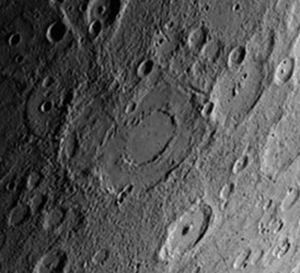Tags
basin, comet, crater, ejecta, Geologic Map of the Bach (H-15) Quadrangle of Mercury, gravity, Mariner 10, mercury, MESSENGER, meteorite, Moon, planet, planetesimal, quadrangle, space, spacecraft, volcano

Bach crater on Mercury
Named after the eighteenth-century composer, Bach crater, a double-ringed basin that displays an extensive field of secondary craters, is a prominent feature of the Bach quadrangle, the south polar part of Mercury poleward of latitude 65° S. Along with other craters of a wide variety of sizes and morphologies, the surface of the Bach quadrangle consists of plains units, fault scarps and ridges that were first photographed during the three Mariner 10 encounters. With MESSENGER‘s 14 January 2008 flyby, previously unseen portions of this region were also imaged.
Superposition of relations among craters and basins, along with their ejecta, have provided the best means of establishing the relative time-stratigraphic order of crater and basin materials on Mercury. Relative to the Moon, stratigraphic relations among mercurian craters are more clearly discerned because the planet has a lower density of large craters and its enhanced gravitational acceleration has restricted the distribution of ejecta. As a result, five crater ages are defined and used to make stratigraphic assignments.
Bach crater (200 km in diameter) is moderately fresh (of c3 age) and has a well-defined secondary-crater field. Like all of the craters within the Bach region, likely resulting from impacts by meteorites, small planetesimals and possibly comets, Bach crater’s inner ring is about half the diameter of its outer ring and consists of an almost continuous series of sharp-crested hills. The area within it and part of the area between it and the outer ring are filled with plains material consisting of a thin, discontinuous layer of very smooth plains material that mantles older smooth units.
No source basin is evident for the mercurian smooth and very smooth plains units within the imaged part of the Bach region. Although such a source basin may lie within the part of the quadrangle that has not yet been imaged, intervening areas do not contain smooth or very smooth plains materials. For these reasons, a volcanic origin is tentatively ascribed to most of the smooth and very smooth plains material found in Bach crater.
– Geologic Map of the Bach (H-15) Quadrangle of Mercury
